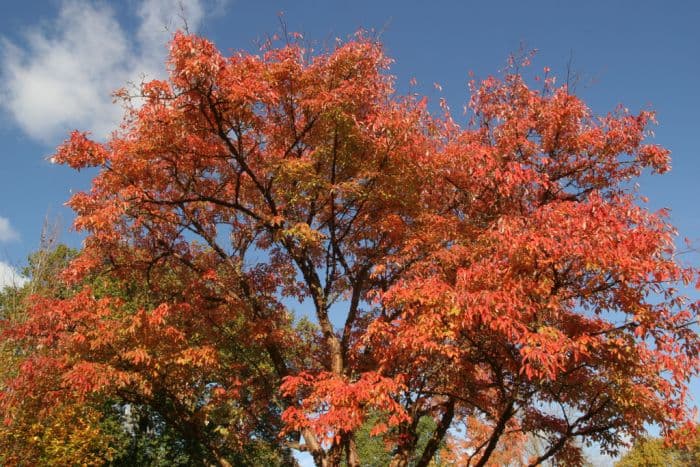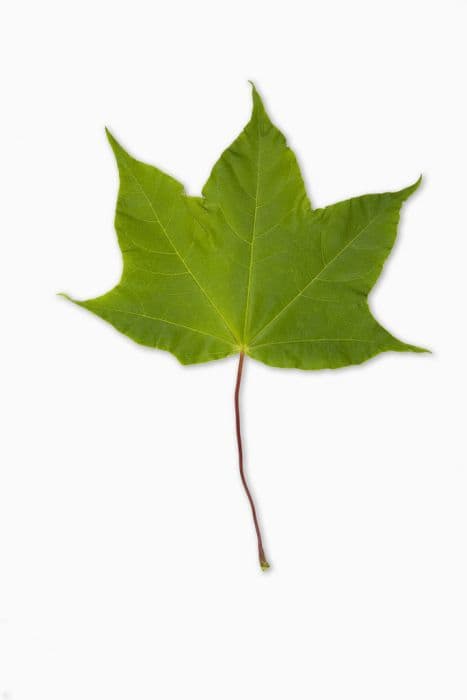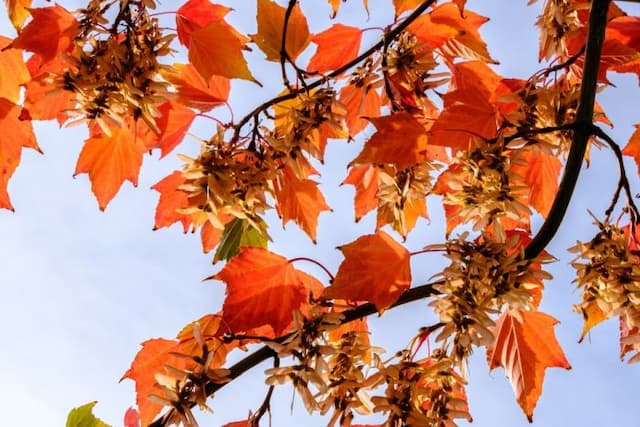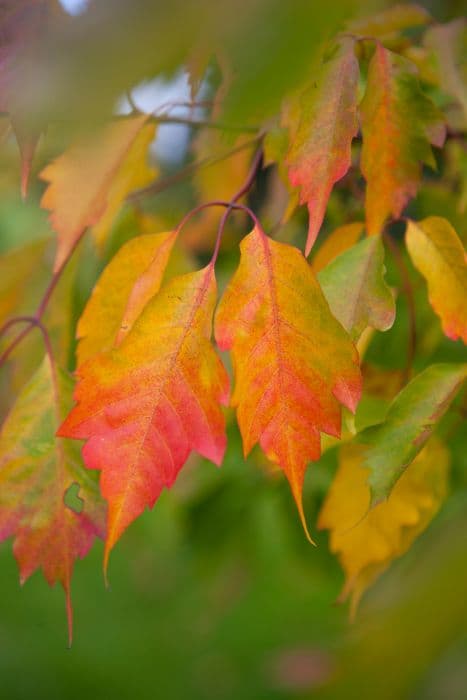Paperbark Maple Acer griseum

ABOUT
Acer griseum, commonly known as the Paperbark Maple, is a striking plant known for its ornamental features, most notably its bark. The tree's bark is a cinnamon-brown color, which exfoliates in papery sheets, giving rise to its common name. This peeling bark provides year-round interest, revealing the brighter, coppery-brown new bark underneath, creating a beautiful contrast against the backdrop of a garden or naturalized area. Aside from its distinctive bark, the Paperbark Maple has a refined structure with a rounded to oval crown, composed of upright-arching branches and a picturesque, open habit. This plant showcases trifoliate leaves which are arranged opposite each other on the twigs. Each leaf typically consists of three leaflets, which are oval with pointed tips. The foliage transitions through the seasons, starting as a soft green in spring, turning a dark green in summer, and then, in a splendid show of autumn color, shifts to vivid shades of red and orange. During the springtime, small, inconspicuous flowers may appear. They are followed by winged seeds known as samaras, which appear in pairs and are typically green or brown when mature. These seeds are a feature of interest as well, often catching the eye as they spin to the ground in the breeze. Overall, the Paperbark Maple is celebrated for its four-season beauty, with the most pronounced feature being its peeling bark that remains visually engaging throughout the year.
About this plant
 Names
NamesSynonyms
Paperbark Maple, Cinnamonbark Maple, Chinese Red-bark Maple.
Common names
Acer nikoense var. griseum, Acer griseum.
 Toxicity
ToxicityTo humans
The Paperbark Maple (Acer griseum) is not widely known to be toxic to humans. There are no significant reports or evidence indicating toxicity that would result in poisoning from the ingestion of parts of the Paperbark Maple. As with any plant material, individual reactions can vary, and it is generally advisable not to consume parts of ornamental plants due to potential individual sensitivities or the presence of garden chemicals.
To pets
The Paperbark Maple (Acer griseum) is also not widely recognized as a toxic plant to pets, such as dogs and cats. There is no substantial evidence to suggest that ingestion of parts of the Paperbark Maple will result in poisoning or severe illness in pets. However, pet owners should still prevent pets from ingesting plants, as individual animals may have different sensitivities or reactions, and some parts of plants can cause gastrointestinal upset even if they are not classically toxic.
 Characteristics
CharacteristicsLife cycle
Perennials
Foliage type
Deciduous
Color of leaves
Green
Flower color
Yellow
Height
20-30 feet [6-9 meters]
Spread
15-25 feet [4.5-7.5 meters]
Plant type
Tree
Hardiness zones
5
Native area
China
Benefits
 General Benefits
General Benefits- Ornamental Appeal: Acer griseum, commonly known as Paperbark Maple, is valued for its attractive, peeling, cinnamon-brown bark which adds visual interest, especially during the winter months when the tree is leafless.
- Seasonal Interest: This plant has vibrant red to orange fall foliage, adding seasonal color to gardens and landscapes.
- Habitat Support: It can provide food and nesting opportunities for birds and other wildlife.
- Durable: It is known for its hardiness and can tolerate a range of soil conditions, which makes it a reliable choice for different landscape settings.
- Shade Provision: Grows to a moderate size and can provide shade in gardens, parks, and streets, without becoming too large or unmanageable.
- Urban Tolerant: Shows a level of tolerance to urban pollution, making it suitable for city environments.
- Low Maintenance: Requires minimal pruning and is generally free from serious pests and diseases, making it a low-maintenance option for gardeners.
 Medical Properties
Medical PropertiesThis plant is not used for medical purposes.
 Air-purifying Qualities
Air-purifying QualitiesThis plant is not specifically known for air purifying qualities.
 Other Uses
Other Uses- The Paperbark Maple's exfoliating copper-orange to cinnamon-red bark can be utilized in crafting and decorating, particularly for rustic and natural-themed projects.
- The tree's wood, though not commonly used due to the tree's small size and rarity, can be crafted into fine, decorative wooden objects or used in woodworking for its unique appearance.
- Landscapers and gardeners value Paperbark Maple for bonsai due to its attractive bark and foliage, allowing enthusiasts to create miniaturized trees with a distinct appearance.
- The fallen leaves of the Paperbark Maple can be collected and used to create a natural mulch or compost, contributing nutrients back to the garden soil.
- The dense canopy of the Paperbark Maple provides shelter for wildlife, offering a habitat for birds and small mammals within a garden setting.
- Photographers and painters often use the striking appearance of the Paperbark Maple as a subject for their work, capturing the beauty of the peeling bark and lush foliage.
- The distinctive bark texture of the Paperbark Maple can be used for imprinting patterns in clay or plaster in crafts, creating natural motifs for art projects.
- In educational environments, the Paperbark Maple can be utilized as a teaching tool for horticulture and botany students, demonstrating characteristics of Aceraceae family members.
- The tree's tolerance for urban pollution makes it a good candidate for urban greening projects, contributing to the aesthetic improvement of cityscapes.
- The Paperbark Maple can act as a natural privacy screen in residential landscapes, offering a visually pleasing barrier between properties.
Interesting Facts
 Feng Shui
Feng ShuiThe Paperbark Maple is not used in Feng Shui practice.
 Zodiac Sign Compitability
Zodiac Sign CompitabilityThe Paperbark Maple is not used in astrology practice.
 Plant Symbolism
Plant Symbolism- Resilience: Acer griseum, commonly known as the Paperbark Maple, has a peeling bark that represents the ability to withstand adverse conditions and bounce back from challenges.
- Change and Transformation: The tree's seasonal color changes from lush green to fiery red symbolize life's ever-changing nature and personal transformation.
- Protection: The distinctive bark that resembles paper but is quite sturdy offers the symbolism of protection and care.
- Longevity: Paperbark Maples are known for their longevity, thus symbolizing endurance and the passage of time.
- Wisdom: In various cultures, maples are often associated with wisdom and intelligence due to their long lifespan and stately growth.
 Water
WaterThe Paperbark Maple (Acer griseum) requires consistent moisture and should be watered weekly or when the top few inches of soil begin to feel dry. Aim to provide this tree with about 1.5 gallons of water per week during the growing season, adjusting as needed for rainfall, temperature, and soil conditions. For newly planted trees, increase the frequency to twice a week to help establish their root systems. During the dormant season, reduce watering, but make sure it still gets water if there are extended dry periods. Avoid overwatering, as poor drainage can lead to root rot.
 Light
LightThe Paperbark Maple thrives in full sun to partial shade. It is best positioned in a spot where it can receive at least four to six hours of direct sunlight per day. However, in regions with particularly hot summers, a location with afternoon shade will help protect the tree from excessive heat.
 Temperature
TemperatureThe Paperbark Maple prefers temperate conditions and can tolerate a temperature range from about -20 to 80 degrees Fahrenheit. The ideal growing temperature for this tree is generally between 60 and 75 degrees Fahrenheit. It is hardy and can withstand occasional winter chill down to its minimum tolerance but may suffer in prolonged periods of extreme heat or cold outside this range.
 Pruning
PruningPruning the Paperbark Maple is essential for maintaining its shape, removing any dead or diseased branches, and encouraging healthy growth. The best time to prune is late winter or early spring before new growth begins. Prune sparingly to maintain its natural form and only as needed to remove any problematic branches. Over-pruning can harm the tree's health and growth patterns.
 Cleaning
CleaningAs needed
 Soil
SoilThe Paperbark Maple thrives in well-draining, loamy soil with a pH between 5.5 and 7.5. A mix of two parts loam, one part peat, and one part sand or fine bark is ideal for this tree, providing proper drainage and a slightly acidic to neutral environment favorable for its growth.
 Repotting
RepottingThe Paperbark Maple is a slow-growing tree that typically does not need frequent repotting. It should be repotted every 3-5 years, or when it becomes root-bound or the soil is depleted. Young trees may require more frequent repotting to accommodate rapid growth periods.
 Humidity & Misting
Humidity & MistingThe Paperbark Maple is adaptable to a wide range of humidity levels and is generally not fussy about atmospheric moisture. However, it does best in moderate humidity conditions typical of its native woodland habitat.
 Suitable locations
Suitable locationsIndoor
Provide bright, indirect light and protect from drafts.
Outdoor
Plant in partial shade, shelter from strong winds.
 Life cycle
Life cycleThe life of Acer griseum, commonly known as the Paperbark Maple, begins with the germination of its small winged seeds, typically after a period of stratification, which simulates winter conditions. Upon germination, the seeds sprout into seedlings, which develop a taproot and begin forming their first true leaves. As the seedlings grow, they enter a juvenile phase, characterized by rapid growth and the development of the distinctive papery, exfoliating bark. The tree then reaches maturity, where it starts to flower and subsequently produces seeds; this reproductive phase can occur when the tree is around 20 years old. Throughout its life, which can span over 100 years, the Paperbark Maple will undergo cycles of growth and dormancy, aligning with the seasons. Ending its life cycle, the tree will eventually senesce and die, potentially leaving behind seeds to give rise to new generations.
 Propogation
PropogationPropogation time
Late winter
The most popular method of propagating the Paperbark Maple, scientifically known as Acer griseum, is by seed. The best time to collect the seeds is in the fall when they have matured and turned a deep brown color. Once collected, the winged seeds should be sown immediately or stratified before spring sowing. Stratification involves mixing the seeds with moist sand and placing them in a plastic bag, which then needs to be stored in a refrigerator at about 34-40 degrees Fahrenheit (1-4 degrees Celsius) for 90 to 120 days to break dormancy. After stratification, seeds are sown in pots or a prepared seedbed in spring, lightly covered with soil, and kept consistently moist. Germination can be slow and erratic, but patience is rewarded as the seedlings gradually develop into the beautiful and unique Paperbark Maple trees.









